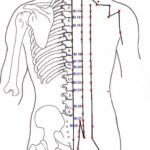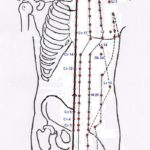Back Transport Points and Alarm Points
The back transport points are located in the back region, and the alarm points are in the front of the body. They are closely related to the internal organs, because qi from the organs can easily infuse or gather in these points. Clinically, the points help to evaluate the functional state of organs, as any change in them reflect dysfunction of the corresponding organs. For example, when experiencing stomach pain, zhong wan (Cv 12) may appear tenderness or other sensitive reactions, in which is the location of the back transport point for the stomach.
All of the back transport points are located on the bladder meridian (section along the sides of the spine), and they are named according to their corresponding organs in Chinese. Stimulating them can directly regulate the functions of their corresponding organs; therefore they are frequently used in the treatment of five zang organ diseases. Moreover, they are also used to treat tissue or structural problems that correspond to these organs. For example, the liver's point gan shu (Bl 18) can be selected for vision problems and cramps (as the liver opens into eyes, and rules tendons) ; the kidney's point shen shu (Bl 23) can be selected for ear ringing, poor hearing, impotence, and bone diseases (as all of these are related to kidney functions).
The alarm points are either on the Conception Vessel, or the sides of this meridian. They frequently used for diagnosing and treating problems of six fu organs or yang meridians (the stomach, gallbladder, bladder, large and small intestines). For example, zhong wan (Cv 12) will be selected for stomach pain; abdominal pain or diarrhea can select tian shu (St 25) for treatment; and zhong ji (Cv 3) will be selected for sciatica.
For the best results, when treating zang organ diseases, it is advised to select a corresponding back transport point as the major acupoint and then in conjunction with its alarm point as assistant. On the other hand, for fu organ diseases, it is advisable to select a corresponding alarm point as the major acupoint and then select its back transport point as assistant. For example, for stomach pain, a needle will first be inserted on zhang wan (Cv 12) and then wei shu (Bl 21); for lung diseases, stimulation is first applied on fei shu (Bl 13) and then on zhong fu (Lu 1).
Table of Back Transport Points and Alarm Points of the Zang and Fu Organs
| Organs | Back transport points | Alarm points |
| Lungs | fei shu (Bl 13) | zhong fu (Lu 1) |
| Large Intestine | da chang shu (Bl 25) | tian shu (St 25) |
| Stomach | wei shu (Bl 21) | zhong wan (Cv 12) |
| Spleen | pi shu (Bl 20) | zhang men (Lr 13) |
| Heart | xin shu (Bl 15) | ju que (Cv 14) |
| Small Intestine | xiao chang shu (Bl 27) | guan yuan (Cv 4) |
| Bladder | pang guang shu (Bl 28) | zhong ji (Cv 3) |
| Kidneys | shen shu (Bl 23) | jing men (Gb 25) |
| Pericardium | jue yin shu (Bl 14 ) | tan zhong (Cv 17) |
| Triple Burner | san jiao shu (Bl 22) | shi men (Cv 5) |
| Gallbladder | dan shu (Bl 19) | ri yue (Gb24) |
| Liver | gan shu (Bl 18) | qi men (Lr 14) |

Distribution of the back transport points (click to enlarge)

Distribution of the alarm points (click to enlarge)


